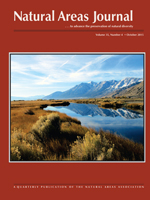Cross Timbers forests of south-central North America contain large expanses of relatively undisturbed old-growth forest where gap-phase regeneration is the main mode of canopy replacement. These forests are threatened by fire suppression, overgrazing, invasive species, global climate change, and urban development. To characterize dynamics of stand development and learn whether canopy trees lost in tree-fall gaps were being replaced by trees of the same species, we conducted a study of tree-fall gaps and their regeneration in three widely separated Oklahoma Cross Timbers forests. Eleven species were found in the forest canopy and three species dominated: post oak (Quercus stellata) (76%), blackjack oak (Q. marilandica) (7%), and black hickory (Carya texana) (10%). Although gaps were small (13–30 m2) resulting from the death of one to two trees, regeneration did not appear to depend on gap size. There was abundant regeneration even in the understory of the closed canopy; most likely much of it was sprouts of dominant species stimulated by burning. Regeneration was very slow, apparently due to drought, which may have been so limiting as to reduce the benefit of gaps. There was no evidence that canopy species composition was on track to change, as the most common canopy tree species whose deaths resulted in a gap, were also the most common tree species regeneration to fill the canopy gap.
How to translate text using browser tools
1 October 2015
Tree-Fall Gaps and Regeneration in Old-Growth Cross Timbers Forests
Laxman Karki,
Stephen W. Hallgren
ACCESS THE FULL ARTICLE

Natural Areas Journal
Vol. 35 • No. 4
October 2015
Vol. 35 • No. 4
October 2015
drought
fire
Quercus marilandica
Quercus stellata
xeric oak forest




